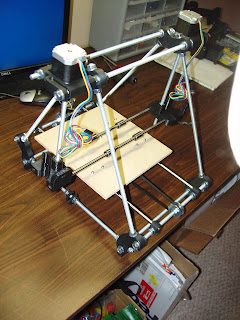Video 14 was a challenging one to follow.
This video starts out with instructions on attaching the hot end to the extruder using some M3 bolts, but at 4:19 into the video an overlay appears saying: "The latest version of this kit includes an aluminum mounting plate. You no longer need to use bolts to secure the hotend. The notches on the top of the hotend slide into the aluminum plate and the plate gets sandwiched between the extruder body and the x carriage. The bolts were not as effective."
My interpretation: ignore the first 4:19 of this video. Instead, slide the hot end into the aluminum plate and leave it aside. It appears that the extruder body + aluminum plate + x carriage "sandwich" will be created in a later video using 2 M4 20mm bolts.
In this video, we will:
- prepare the hot end by sliding into aluminum plate
- prepare the extruder body
 |
| Hot end attached to the aluminum plate |
Building the Extruder Body
Things you'll need (pics of all parts appear here):
Printed parts: Extruder, idler, small gear, large gear
Metal parts: hobbed bolt and the M8 locknut that comes with it. Short M8 smooth rod (about 15mm long)
Hardware: 3 bearings, 2 springs, 30 mm M3 bolt, 2 60 mm M3 bolts, 2 M8 washers, 2 M8 nuts, 1 M3 locknut, 7 M3 washers, 4 10mm M3 bolts, 3 M3 nuts
First thing, make sure you clean up the printed parts. On the extruder, make sure that you drill out the 3 holes for the stepper motor mounting, the hole for the hobbed bolt. Clean up the slots for the M3 nuts on the extruder and the small gear - I used an Xacto knife for this. Make sure that the idler fits onto the extruder - I found that a lot of excess material had to be removed.
Prepare the large gear: put the M8 locknut on the hobbed bolt. Slide the hobbed bolt through the large gear.
 |
| Large gear with hobbed bolt |
 |
| Large gear with hobbed bolt showing M8 locknut |
Prepare the extruder for installation of the large gear: Install two bearings in the extruder. Slide the hobbed bolt through the two bearings. Tighten the M8 locknut until the ridges on the hobbed bolt line up with the center hole on the extruder. Complete the installation of the large gear by sliding 2 M8 washers into the loose end of the hobbed bolt and tighten with 2 M8 nuts.
 |
| Extruder with bearing installed |
 |
| Extruder showing both bearings |
 |
| Large wheel and hobbed bolt installed onto the extruder |
 |
| Adjusting the M8 locknut so that the grooves on the hobbed bolt line up with the hole for the filament |
 |
| Tightening the hobbed bolt with 2 M8 nuts (on the right) |
Prepare the idler: Install a bearing on the short M8 smooth rod and slip into the idler.
 |
| Preparing the idler with a bearing and a short M8 rod (1) |
 |
| Preparing the idler with a bearing and a short M8 rod (2) |
Install the idler: Slide the idler onto the extruder. Attach the idler to the extruder using a 30 mm M3 bolt and an M3 locknut. Insert the bolt where the large gear is - through the extruder, into the idler, back into the extruder. If you insert the bolt the other way, the large gear will hit on the M3 locknut.
 |
| Idler attached to extruder using 30mm M3 bolt and M3 locknut. M3 locknut displayed here. |
Install the tightening screws: slip two M3 nuts into slots on the idler. Prepare two 60mm M3 bolts by placing an M3 washer, a spring and another M3 washer on them. Insert the 60mm M3 bolts through the idler and into the 2 M3 nuts that you slipped into the extruder and tighten until the springs have been compressed to about 20 mm.
 |
| Install two M3 nuts (drop them into the two slots) |
 |
| 2 60mm M3 bolts installed and tightened |
Attach the stepper motor to the extruder: Using 3 M3 10 mm bolts and 3 washers. Orient the stepper motor so that the wire point down (see pics). Do not tighten yet.
 |
| Stepper motor attached to extruder |
Install the Small gear: drop an M3 nut into a little slot in the small gear. Slide the small gear into the shaft of the stepper motor and insert a 10mm M3 screw into the side of the small gear and screw it in so it catches on the M3 nut. Line up with the screw on the small gear with the flat part of the stepper motor shaft. Tighten the screw.
 |
| Prepare the small gear by dropping a nut into the slot on the side |
 |
| Small gear has been installed |
Important note: I found that the M3 10 mm screw that was holding the small gear in place was hitting the extruder, so the small gear was not rotating freely. I had to shorten the M3 10 mm screw to about 8 mm. I did this using a Dremel tool with a cutting blade.
Last thing: make sure that you rotate the large gear several times around to make sure it rotates smoothly against the small gear. If it sticks, you'll need to remove excess printed material until things turn smoothly. I used an Xacto knife to do this.
 |
| Extruder assembly complete (1/4) |
 |
| Extruder assembly complete (2/4) |
 |
| Extruder assembly complete (3/4) |
 |
| Extruder assembly complete (4/4) |
























